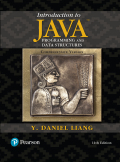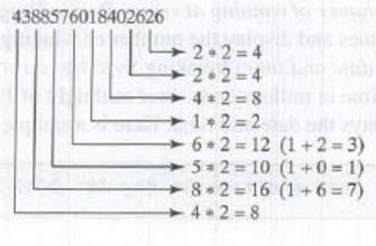
(Financial: credit card number validation) Credit card numbers follow certain patterns. A credit card number must have between 13 and 16 digits. It must start with
- for Visa cards
- for Master cards
- for American Express cards
- for Discover cards
In 1954, Hans Luhn of IBM proposed an
- 1. Double every second digit from right to left. If doubling of a digit results in a two-digit number, add up the two digits to get a single-digit number.

- 2. Now add all single-digit numbers from Step 1.
4 + 4 + 8 + 2 + 3 + 1 + 7 + 8 = 37
- 3. Add all digits in the odd places from right to left in the card number.
6 + 6 + 0 + 8 + 0 + 7 + 8 + 3 = 38
- 4. Sum the results from Step 2 and Step 3.
37+38=75
- 5. If the result from Step 4 is divisible by 10, the card number is valid; otherwise, it is invalid. For example, the number 4388576018402626 is invalid, but the number 4388576018410707 is valid.
Write a
/** Return true if the card number is valid */
public static boolean isValid(long number)
/** Get the result from Step 2 */
public static int sumOfDoubleEvenPlace(long number)
/** Return this number if it is a single digit, otherwise, • return the sum of the two digits */
public static int getDigit(int number)
/** Return sum of odd-place digits in number */
public static int sumOfOddPlace(long number)
/** Return true if the number dis a prefix for number *I
public static boolean prefixMatched(long number, int d)
/** Return the number of digits in d */
public static int getSize(long d)
/ ** Return the first k number of digits from number. If the • number of digits in number is less than k, return number. */
public static long getPrefix(long number , int k)
Here are sample runs of the program: (You may also implement this program by reading the input as a string and processing the string to validate the credit card.)

Trending nowThis is a popular solution!

Chapter 6 Solutions
Introduction to Java Programming and Data Structures Comprehensive Version (11th Edition)
Additional Engineering Textbook Solutions
Starting Out with C++ from Control Structures to Objects (9th Edition)
Starting Out with Java: From Control Structures through Data Structures (4th Edition) (What's New in Computer Science)
Electric Circuits. (11th Edition)
INTERNATIONAL EDITION---Engineering Mechanics: Statics, 14th edition (SI unit)
Starting Out with Java: From Control Structures through Objects (7th Edition) (What's New in Computer Science)
- If a new entity Order_Details is introduced, will it be a strong entity or weak entity? If it is a weak entity, then mention its type (ID or Non-ID, also Justify why)?arrow_forwardWhich one of the 4 Entities mention in the diagram can have a recursive relationship? Order, Product, store, customer.arrow_forwardInheritance & Polymorphism (Ch11) There are 6 classes including Person, Student, Employee, Faculty, and Staff. 4. Problem Description: • • Design a class named Person and its two subclasses named student and Employee. • Make Faculty and Staff subclasses of Employee. • A person has a name, address, phone number, and e-mail address. • • • A person has a class status (freshman, sophomore, junior and senior). Define the status as a constant. An employee has an office, salary, and date hired. A faculty member has office hours and a rank. A staff member has a title. Override the toString() method in each class to display the class name and the person's name. 4-1. Explain on how you would code this program. (1 point) 4-2. Implement the program. (2 point) 4-3. Explain your code. (2 point)arrow_forward
- Suppose you buy an electronic device that you operate continuously. The device costs you $300 and carries a one-year warranty. The warranty states that if the device fails during its first year of use, you get a new device for no cost, and this new device carries exactly the same warranty. However, if it fails after the first year of use, the warranty is of no value. You plan to use this device for the next six years. Therefore, any time the device fails outside its warranty period, you will pay $300 for another device of the same kind. (We assume the price does not increase during the six-year period.) The time until failure for a device is gamma distributed with parameters α = 2 and β = 0.5. (This implies a mean of one year.) Use @RISK to simulate the six-year period. Include as outputs (1) your total cost, (2) the number of failures during the warranty period, and (3) the number of devices you own during the six-year period. Your expected total cost to the nearest $100 is _________,…arrow_forwardWhich one of the 4 Entities mention in the diagram can have a recursive relationship? If a new entity Order_Details is introduced, will it be a strong entity or weak entity? If it is a weak entity, then mention its type (ID or Non-ID, also Justify why)?arrow_forwardPlease answer the JAVA OOP Programming Assignment scenario below: Patriot Ships is a new cruise line company which has a fleet of 10 cruise ships, each with a capacity of 300 passengers. To manage its operations efficiently, the company is looking for a program that can help track its fleet, manage bookings, and calculate revenue for each cruise. Each cruise is tracked by a Cruise Identifier (must be 5 characters long), cruise route (e.g. Miami to Nassau), and ticket price. The program should also track how many tickets have been sold for each cruise. Create an object-oriented solution with a menu that allows a user to select one of the following options: 1. Create Cruise – This option allows a user to create a new cruise by entering all necessary details (Cruise ID, route, ticket price). If the maximum number of cruises has already been created, display an error message. 2. Search Cruise – This option allows to search a cruise by the user provided cruise ID. 3. Remove Cruise – This op…arrow_forward
- I need to know about the use and configuration of files and folders, and their attributes in Windows Server 2019.arrow_forwardSouthern Airline has 15 daily flights from Miami to New York. Each flight requires two pilots. Flights that do not have two pilots are canceled (passengers are transferred to other airlines). The average profit per flight is $6000. Because pilots get sick from time to time, the airline is considering a policy of keeping four *reserve pilots on standby to replace sick pilots. Such pilots would introduce an additional cost of $1800 per reserve pilot (whether they fly or not). The pilots on each flight are distinct and the likelihood of any pilot getting sick is independent of the likelihood of any other pilot getting sick. Southern believes that the probability of any given pilot getting sick is 0.15. A) Run a simulation of this situation with at least 1000 iterations and report the following for the present policy (no reserve pilots) and the proposed policy (four reserve pilots): The average daily utilization of the aircraft (percentage of total flights that fly) The…arrow_forwardWhy is JAVA OOP is really difficult to study?arrow_forward
- My daughter is a Girl Scout and it is time for our cookie sales. There are 15 neighbors nearby and she plans to visit every neighbor this evening. There is a 40% likelihood that someone will be home. If someone is home, there is an 85% likelihood that person will make a purchase. If a purchase is made, the revenue generated from the sale follows the Normal distribution with mean $18 and standard deviation $5. Using @RISK, simulate our door-to-door sales using at least 1000 iterations and report the expected revenue, the maximum revenue, and the average number of purchasers. What is the probability that the revenue will be greater than $120?arrow_forwardQ4 For the network of Fig. 1.41: a- Determine re b- Find Aymid =VolVi =Vo/Vi c- Calculate Zi. d- Find Ay smid e-Determine fL, JLC, and fLE f-Determine the low cutoff frequency. g- Sketch the asymptotes of the Bode plot defined by the cutoff frequencies of part (e). h-Sketch the low-frequency response for the amplifier using the results of part (f). Ans: 28.48 2, -72.91, 2.455 KS2, -54.68, 103.4 Hz. 38.05 Hz. 235.79 Hz. 235.79 Hz. 14V 15.6ΚΩ 68kQ 0.47µF Vo 0.82 ΚΩ V₁ B-120 3.3kQ 0.47µF 10kQ 1.2k0 =20µF Z₁ Fig. 1.41 Circuit forarrow_forwarda. [10 pts] Write a Boolean equation in sum-of-products canonical form for the truth table shown below: A B C Y 0 0 0 1 0 0 1 0 0 1 0 0 0 1 1 0 1 0 0 1 1 0 1 0 1 1 1 1 0 1 1 0 a. [10 pts] Minimize the Boolean equation you obtained in (a). b. [10 pts] Implement, using Logisim, the simplified logic circuit. Include an image of the circuit in your report.arrow_forward
 C++ Programming: From Problem Analysis to Program...Computer ScienceISBN:9781337102087Author:D. S. MalikPublisher:Cengage Learning
C++ Programming: From Problem Analysis to Program...Computer ScienceISBN:9781337102087Author:D. S. MalikPublisher:Cengage Learning C++ for Engineers and ScientistsComputer ScienceISBN:9781133187844Author:Bronson, Gary J.Publisher:Course Technology Ptr
C++ for Engineers and ScientistsComputer ScienceISBN:9781133187844Author:Bronson, Gary J.Publisher:Course Technology Ptr Microsoft Visual C#Computer ScienceISBN:9781337102100Author:Joyce, Farrell.Publisher:Cengage Learning,
Microsoft Visual C#Computer ScienceISBN:9781337102100Author:Joyce, Farrell.Publisher:Cengage Learning, Systems ArchitectureComputer ScienceISBN:9781305080195Author:Stephen D. BurdPublisher:Cengage Learning
Systems ArchitectureComputer ScienceISBN:9781305080195Author:Stephen D. BurdPublisher:Cengage Learning EBK JAVA PROGRAMMINGComputer ScienceISBN:9781337671385Author:FARRELLPublisher:CENGAGE LEARNING - CONSIGNMENTProgramming Logic & Design ComprehensiveComputer ScienceISBN:9781337669405Author:FARRELLPublisher:Cengage
EBK JAVA PROGRAMMINGComputer ScienceISBN:9781337671385Author:FARRELLPublisher:CENGAGE LEARNING - CONSIGNMENTProgramming Logic & Design ComprehensiveComputer ScienceISBN:9781337669405Author:FARRELLPublisher:Cengage





